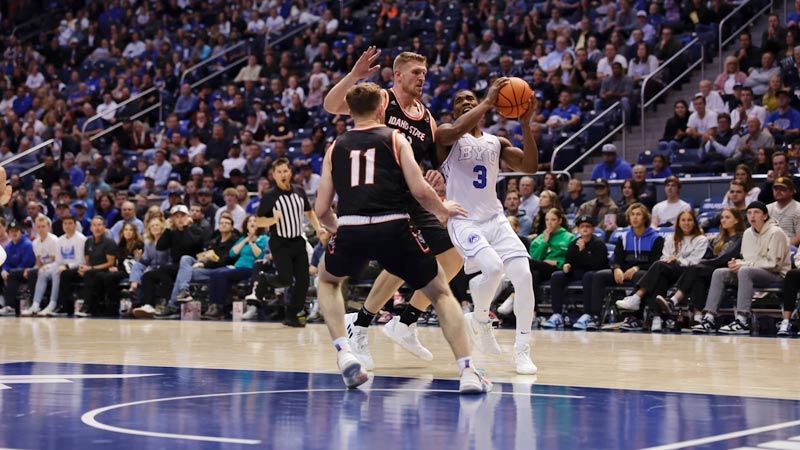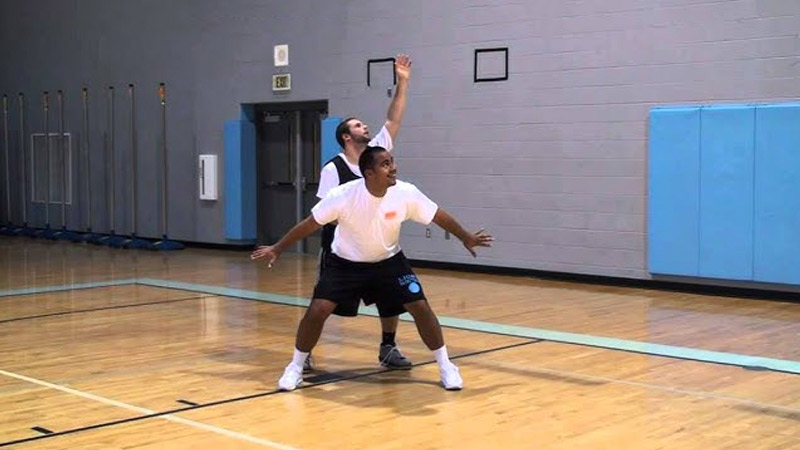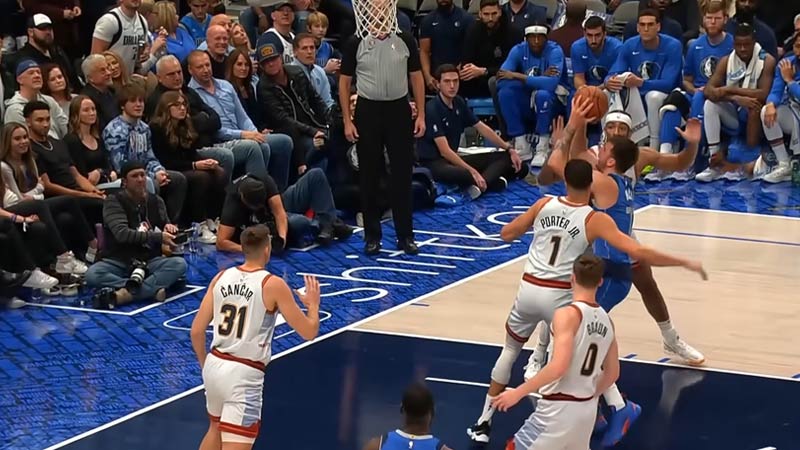Basketball is a highly competitive sport that requires players to excel in various skills and techniques.
One such essential skill is box out, also known as blocking out. Boxing out is a fundamental defensive technique used to gain positioning and secure rebounds.
In this article, we will delve into the intricacies of box out in basketball, exploring its purpose, and the level of contact involved.
Also, we will deal with drill variations when to use them, and a step-by-step guide on how to execute a box out effectively. Let’s get started.
What Is Box Out in Basketball?
Boxing out in basketball refers to the defensive technique of creating space between an opponent and the basket to gain a rebounding advantage.
It is a fundamental skill utilized by players to secure rebounds and prevent opponents from scoring second-chance points. Real-life data shows the significance of boxing out in basketball.
For example, during the 2020-2021 NBA season, the Utah Jazz led the league in rebounding with an average of 48.3 rebounds per game, showcasing their commitment to boxing out and dominating the boards.
Additionally, teams with strong box-out fundamentals often have higher rebounding percentages, translating into more possessions and scoring opportunities.
Level of Contact in Box Out
Boxing out involves creating space between an opposing player and the basket to gain a rebounding advantage.
It is important to note that box-out techniques should be legal and not involve excessive physical contact or fouling.
The level of contact allowed in box-out situations varies depending on the league, level of play, and the specific game’s officiating style.
Players must understand and adapt to the specific rules and regulations governing contact during box outs to avoid unnecessary fouls or violations.
Types of Box-Out Drill Variations
To enhance box-out skills, basketball coaches implement various drill variations during training sessions.
These drills target different aspects of box-out techniques, such as footwork, positioning, timing, and strength. Let’s explore some common box out drill variations:
One-on-One Box Out Drill

This drill replicates a game-like situation where players compete against each other to gain positioning and secure rebounds. It emphasizes body control, balance, and effective use of leverage.
Players learn how to establish and maintain a solid box-out position while fending off opponents’ attempts to gain an advantage.
Box Out Pad Drill
In this drill, players utilize pads or blocking dummies to simulate opponents. It aims to develop the physicality and strength necessary to hold position and create space during a box out.
By repeatedly engaging with the pads, players improve their ability to absorb contact, maintain balance, and establish a strong presence on the court.
Reaction Box Out Drill
The focus of this drill is to enhance players’ reaction time and agility when it comes to boxing out. It involves rapid movements and quick adjustments to respond to rebounds and opponents’ positioning.
Players must anticipate the trajectory of the ball and react swiftly to establish a box out and secure the rebound.
Team Box Out Drill
This drill emphasizes teamwork, communication, and coordination in box-out situations. Players practice boxing out multiple opponents simultaneously, replicating scenarios where rebounding requires a collective effort.
It helps players develop a sense of responsibility, coordination, and effective communication to ensure that all opponents are accounted for and boxed out successfully.
These drills target specific aspects of box-out techniques, allowing players to refine their footwork, positioning, timing, and strength.
Consistent practice of these drills enhances players’ ability to secure rebounds, establish control on the court, and contribute significantly to their team’s success.
When to Use Box Out in Basketball?

Boxing out is a defensive technique that should be utilized in various game situations to gain a rebounding advantage and limit the opponent’s scoring opportunities. Here are a few scenarios where box out is particularly crucial:
Rebounding
Rebounding is perhaps the most common and important situation where box out is employed. After a missed shot by the opponent, players must box out to secure the rebound for their team.
By effectively boxing out, players create space, maintain position, and limit the opponent’s chances of getting the rebound.
This is essential for both offensive and defensive players, as it can determine the flow of the game and provide additional scoring opportunities.
Free Throws
Free throw situations offer an opportunity for both offensive and defensive players to benefit from employing box-out techniques.
Offensive players can use box-out techniques to increase their team’s chances of securing an offensive rebound.
By establishing position and boxing out opponents, offensive players can create second-chance scoring opportunities for their team.
On the other hand, defensive players can utilize box-out techniques to prevent opponents from gaining advantageous rebounding positions.
By effectively boxing out, defensive players can limit the opponent’s ability to score easy points off missed free throws.
Fast Breaks
When transitioning from defense to offense or vice versa, box out can play a crucial role in disrupting the opponent’s fast break opportunities.
By establishing strong positioning and boxing out, players can slow down opponents, reduce their scoring opportunities, and regain control of the game’s tempo.
By effectively boxing out on fast breaks, players can impede the progress of opposing players and limit their ability to score easy points in transition.
In general, boxing out is a defensive technique that should be employed in various game situations.
Whether it’s securing rebounds, contesting free throws, or disrupting fast breaks, utilizing box-out techniques can significantly impact a team’s performance on the court.
How to Box Out in Basketball?

Executing a proper box out requires mastering the technique, positioning yourself correctly, and timing your movements effectively.
Here is a step-by-step guide to help you box out effectively on the basketball court:
Identify Your Assignment
Before the shot is taken, identify the opponent you are responsible for boxing out. This requires awareness and communication with your teammates to ensure everyone is accounted for.
Maintain visual contact with both the opponent you’re guarding and the ball to stay engaged in the play.
Position Yourself Correctly
Stand with your feet shoulder-width apart and slightly staggered to establish a solid base. Your body should be facing the opponent you’re boxing out, with your backside toward the basket.
This positioning allows you to maintain control and leverage during the box out.
Establish Contact
As the shot is released, initiate contact with the opponent by extending your arms slightly forward.
Your forearm should make contact with the opponent’s chest, and your hands should be active to maintain control and disrupt their positioning.
Remember, it’s important to maintain legal contact and avoid committing unnecessary fouls.
Push and Maintain Space
Utilize your lower body strength to push against the opponent while maintaining legal contact. Keep a low center of gravity and engage your hips and legs to create space between the opponent and the basket.
This pushing motion helps establish and maintain your position for securing the rebound.
Monitor the Ball
While engaged in the box out, keep a close eye on the flight of the ball. Maintain physical contact with the opponent to prevent them from gaining an advantage but also be aware of the ball’s trajectory.
This allows you to anticipate its path and position yourself accordingly to pursue the rebound.
Secure the Rebound
Once the ball makes contact with the rim, use your positioning and leverage to gain control of the rebound.
Keep your hands up and ready, establish a strong grip on the ball, and use your body to shield opponents from reaching the rebound.
Quickly transition to offense or make an outlet pass to start the fast break and maintain possession for your team.
By following these step-by-step instructions and practicing your box-out technique, you can become a valuable asset in securing rebounds and contributing to your team’s success on the basketball court.
FAQs
Is boxing out only important for taller players?
No, boxing out is important for players of all heights. It is a technique that helps players create space and secure rebounds, regardless of their height advantage.
Can boxing out prevent offensive rebounds?
Yes, boxing out is a crucial defensive technique that can limit the opponent’s chances of securing offensive rebounds. It helps players maintain their position and gain an advantage in rebounding battles.
Are there any specific rules regarding boxing out in basketball?
The rules regarding boxing out vary depending on the league and level of play. Generally, legal boxing out involves maintaining contact within the allowed limits and not committing excessive fouls or violations.
How can I improve my box-out skills?
Practice is key to improving box-out skills. Incorporate box-out drills into your training routine, focus on footwork, positioning, and timing, and work on developing strength and agility to hold your ground against opponents.
Can boxing out help prevent second-chance points?
Yes, boxing out significantly reduces the opponent’s chances of securing offensive rebounds and scoring second-chance points.
By effectively boxing out, players can limit the opponent’s opportunities and regain possession for their team.
Conclusion
Boxing out is a fundamental defensive technique in basketball that helps players secure rebounds and gain a competitive advantage.
It involves creating space between the opponent and the basket while maintaining legal contact and positioning.
By mastering the art of boxing out, players can contribute to their team’s rebounding efforts and limit the opponent’s scoring opportunities.
Utilize the step-by-step guide and incorporate box-out drills into your training routine to enhance your skills on the court.
Remember, boxing out is not only about height but also about technique, positioning, and timing, making it an essential skill for players of all sizes. Thank you.







